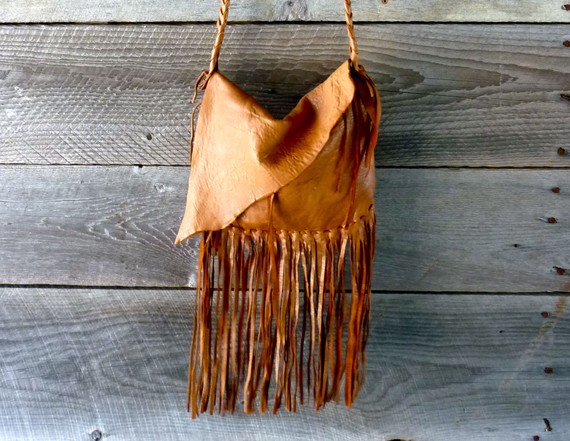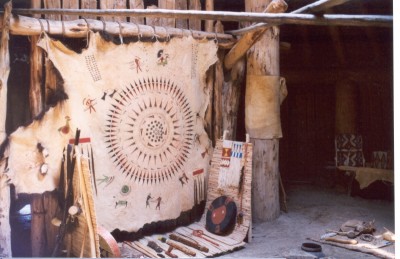How To Make Leather From Animal Skin

Image source: Etsy
I have been obsessed with the indigenous people of America and pioneering skills since I was a little daughter. I began wearing headbands with feathers in them at historic period 3 and making teepees at age four. And when it came fourth dimension to play what was so called "cowboys and Indians," I always played the latter.
As I grew up, I wanted to acquire all of the old-fashioned skills of making things past hand. I learned how to make fire without matches, how to build a shelter out of branches, and how to make soap out of animate being fat. But more than anything, I wanted to make my own elk-hide apparel, like the one worn past "Stands With a Fist" in the movie "Dances with Wolves."
Still, even dorsum in 1992, an elk hide was a hefty $350. I knew I could easily ruin it, so I decided to practice first with roadkill. My first try, using a squirrel, was a complete disaster. I was so excited that I didn't pay much attention to the directions. After a week of trying this and that, I concluded up with what looked like an elongated rawhide dog chew with a few whiskers on one end!
I take learned a neat bargain since those days. While there are dozens of means to tan an animal hide and a wide variety of materials to do it, we will talk almost the most common methods that the native people used.
Diatomaceous Earth: The All-Natural Livestock De-Wormer
Nosotros will focus mainly on deer and elk hides hither. There are slightly dissimilar methods for different types of hides, but these are the two most commonly used hides among native people.
Wet Scrape and Dry Scrape
This is really a matter of preference, and both methods were used by different tribes. The nearly common method appears to exist a dry out scrape. Hides are either secured to a log or tree and then scraped with a bone or stick to remove all bits of flesh and peel membrane. Alternatively, hides were staked to the ground then that all the flesh could be removed. Information technology is imperative that all flesh and membranes be removed from the inside of the skin. If this is not washed, the hide will rot. But while you desire to remove all the flesh, yous don't want to rub so hard that you lot make a hole in the hide. That was something I did repeatedly until I finally got the hang of it!
To remove the hair, the hide should be soaked for a few hours in h2o mixed with woods ashes. Then, using the same type of tool that was used to remove the flesh, the fur tin be removed. At this bespeak, the hide is now set to be tanned.
Using the Animal's Brain

Prototype source: Wikipedia
While at that place are other materials that will piece of work to tan a hide, the about commonly used method was to utilize the brains of the animal. Fifty-fifty if you don't desire to remove the fur, information technology's a proficient idea to soak the hibernate for a few hours in water mixed with some woods ashes. This helps to break down the fibers in the skin and makes penetration of the encephalon mash easier. It also will result in a softer hide.
Many tribes besides added items to the brains to help make the hides softer. Some used the spinal fluid from the fauna, others used the liver, only most tribes used some of the fat from the creature. The brains were smashed into a thick lurid and liquefied fatty, or softened fatty was mixed in. This mixture was and so spread over the inside of the hide and massaged in. The hide was then soaked in h2o for an hour or so. Subsequently that, the water was squeezed or pushed out of the hide (by using a apartment rock or flat slice of forest). Some tribes would wrap the skin around a tree and twist it to get the water out. The hide was and then stretched dorsum into shape and allowed to dry out.
Is At that place More to It?
While this sounds fairly easy, trust me: Information technology is a very labor-intensive process.
Sometimes the brains do not penetrate on the starting time endeavor and this method needs to be repeated. Other times — equally I learned the hard mode with my first squirrel – if you soak the hide too long the hair comes off even if you don't want it to. Which means y'all at present need to scrape that side every bit well and remove ALL the pilus.
Why Are Some Hides Buttery Soft?
Sometimes you want hides that are tough and strong for shoe bottoms or totes, but is there anything nicer than a super soft slice of leather?
To get that buttery-soft feeling, the fibers of the hibernate need to exist broken downwards. Information technology's like to the manner we break down the fibers of meat. Tough meat needs to exist beaten and pierced to break upwards the fibers. Virtually tribes got those soft skins by working the hide over and over until information technology obtained the softness they were looking for. Subsequently tanning, the within of the hibernate was again rubbed with fatty, pulled taut using the preferred method, and and then worked over once more with a rounded stick or rock. Of course, many hands make light piece of work and, in most tribes, women worked together. Just when one considers that most teepees were made from the hides of a dozen animals (or more) sewn together, y'all get a real appreciation for the work that was involved.
Have y'all ever made leather and tanned hide? What advice would you add together? Share your thoughts in the department below:
If You Like All-Natural Home Remedies, You Need To Read Everything That Hydrogen Peroxide Tin can Exercise. Detect Out More than Here.
Source: https://www.offthegridnews.com/how-to-2/the-off-grid-native-american-guide-to-making-leather/
Posted by: byrdboashe.blogspot.com

0 Response to "How To Make Leather From Animal Skin"
Post a Comment